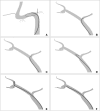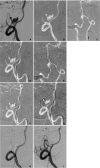Endovascular Treatment of Wide-necked Cerebral Aneurysms with an Acute Angle Branch Incorporated into the Sac: Novel methods of Branch Access in 8 Aneurysms
- PMID: 22970418
- PMCID: PMC3429850
- DOI: 10.5469/neuroint.2012.7.2.93
Endovascular Treatment of Wide-necked Cerebral Aneurysms with an Acute Angle Branch Incorporated into the Sac: Novel methods of Branch Access in 8 Aneurysms
Abstract
Purpose: The optimal management of geometrically complex aneurysms remains challenging. The aim of this retrospective study was to evaluate the safety and feasibility of branch-selective technique (BT) in wide-necked aneurysms with an acute angle branch incorporated into the sac.
Materials and methods: Eight consecutive patients harboring wide-necked cerebral aneurysms with an incorporated, acute angle branch (mean, 30.4°) underwent coiling over an 18-month period. Dome-to-neck ratio ranged from 0.9 to 1.8 (mean, 1.2). Every procedure utilized BT, i.e., stent- or catheter-assisted coiling through the incorporated branch.
Results: Technical success was achieved in all cases. With the aim to avoid the risk of aneurysmal rupture during struggling intraaneurysmal wire navigation, a 'looping method' and retrograde approach of a preshaped 0.014' microcatheter (C or J) was used for branch access in five cases and a 'looping method' and antegrade approach in one case. In the remaining one, just the C-preshape was enough to directly enter the branch without intraaneurysmal wire navigation. Overall, stent-assisted coiling was performed in seven cases, while catheter-assisted coiling was undertaken in one. The only complication was thrombotic posterior inferior cerebellar artery occlusion in one case, which was recanalized after tirofiban infusion. New neurological deficits were not identified in any cases.
Conclusion: BT seems safe and feasible for wide-necked aneurysms with an acute angle branch incorporated into the sac. The looping method may offer safe access to the incorporated, acute angle branch and should be considered for replacement of the fearful intra-aneurysmal wire navigation.
Keywords: Branch-selective technique; Endovascular procedures; Intracranial aneurysm.
Figures



Similar articles
-
Microcatheter Looping Technique Facilitates the Embolization of Complex Intracranial Aneurysms with an Acute Angle Branch Incorporated into the Sac.World Neurosurg. 2017 Apr;100:56-61. doi: 10.1016/j.wneu.2016.12.093. Epub 2016 Dec 31. World Neurosurg. 2017. PMID: 28043886
-
Endovascular treatment of ruptured tiny, wide-necked posterior communicating artery aneurysms using a modified stent-assisted coiling technique.J Clin Neurosci. 2013 Oct;20(10):1377-81. doi: 10.1016/j.jocn.2012.12.012. Epub 2013 Jul 23. J Clin Neurosci. 2013. PMID: 23890412
-
Endovascular embolization of branch-incorporated cerebral aneurysms.Neuroradiol J. 2017 Dec;30(6):600-606. doi: 10.1177/1971400917698002. Neuroradiol J. 2017. PMID: 29171364 Free PMC article.
-
The use of single low-profile visualized intraluminal support stent-assisted coiling in the treatment of middle cerebral artery bifurcation unruptured wide-necked aneurysm.Interv Neuroradiol. 2020 Aug;26(4):461-467. doi: 10.1177/1591019920901925. Epub 2020 Jan 24. Interv Neuroradiol. 2020. PMID: 31979996 Free PMC article.
-
Comaneci Device for Temporary Coiling Assistance for Treatment of Wide-Necked Aneurysms: Initial Case Series and Systematic Literature Review.World Neurosurg. 2021 May;149:e85-e91. doi: 10.1016/j.wneu.2021.02.080. Epub 2021 Feb 25. World Neurosurg. 2021. PMID: 33640525
Cited by
-
Angiographic results of wide-necked intracranial aneurysms treated with coil embolization : a single center experience.J Korean Neurosurg Soc. 2015 Apr;57(4):250-7. doi: 10.3340/jkns.2015.57.4.250. Epub 2015 Apr 24. J Korean Neurosurg Soc. 2015. PMID: 25932291 Free PMC article.
-
Microcatheter Looping to Facilitate Aneurysm Selection in Coil Embolization of Paraclinoid Aneurysms.Korean J Radiol. 2015 Jul-Aug;16(4):899-905. doi: 10.3348/kjr.2015.16.4.899. Epub 2015 Jul 1. Korean J Radiol. 2015. PMID: 26175591 Free PMC article.
-
Efficacy and safety of guidewireless catheterization with a steerable microcatheter in patients scheduled for yttrium-90 radioembolization: a prospective multicenter trial.Wideochir Inne Tech Maloinwazyjne. 2020 Sep;15(3):503-510. doi: 10.5114/wiitm.2020.92512. Epub 2020 Jan 21. Wideochir Inne Tech Maloinwazyjne. 2020. PMID: 32904691 Free PMC article.
-
Microcatheter looping facilitates access to both the acutely angled parent artery and cerebral aneurysms for effective embolization.Interv Neuroradiol. 2014 Dec;20(6):669-76. doi: 10.15274/INR-2014-10048. Epub 2014 Dec 5. Interv Neuroradiol. 2014. PMID: 25496676 Free PMC article.
-
Tirofiban combined with urokinase selective intra-arterial thrombolysis for the treatment of middle cerebral artery occlusion.Exp Ther Med. 2016 Mar;11(3):1011-1016. doi: 10.3892/etm.2016.2995. Epub 2016 Jan 14. Exp Ther Med. 2016. PMID: 26998029 Free PMC article.
References
-
- Molyneux AJ, Kerr RS, Yu LM, Clarke M, Sneade M, Yarnold JA, et al. International subarachnoid aneurysm trial (ISAT) of neurosurgical clipping versus endovascular coiling in 2143 patients with ruptured intracranial aneurysms: a randomised comparison of effects on survival, dependency, seizures, rebleeding, subgroups, and aneurysm occlusion. Lancet. 2005;366:809–817. - PubMed
-
- Jayaraman MV, Do HM, Versnick EJ, Steinberg GK, Marks MP. Morphologic assessment of middle cerebral artery aneurysms for endovascular treatment. J Stroke Cerebrovasc Dis. 2007;16:52–56. - PubMed
-
- Sluzewski M, van Rooij WJ, Beute GN, Nijssen PC. Balloon-assisted coil embolization of intracranial aneurysms: incidence, complications, and angiography results. J Neurosurg. 2006;105:396–399. - PubMed
LinkOut - more resources
Full Text Sources

